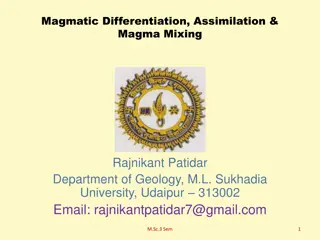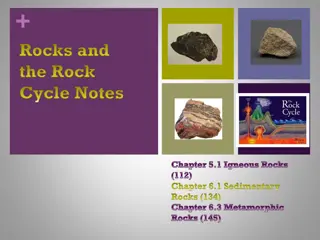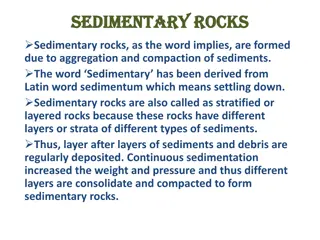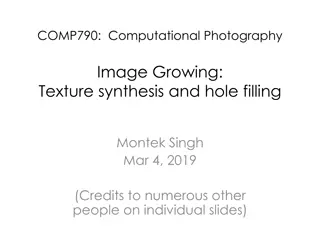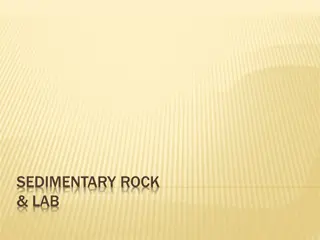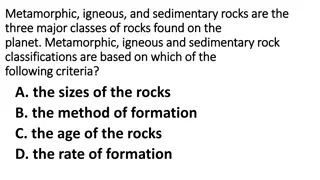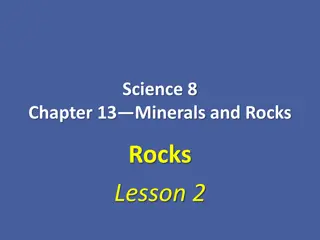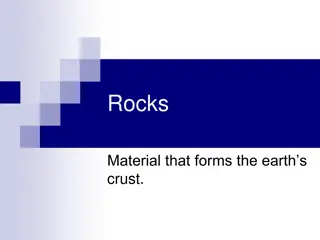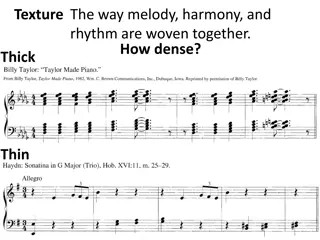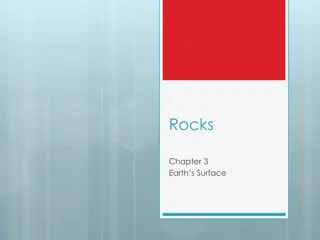Understanding Igneous Rocks Textures
Petrology delves into the study of igneous rocks, focusing on their composition, grain sizes, and textures. From the common feldspar proportions to the classification based on grain sizes, this field provides insights into the formation processes and characteristics of different rock types. The textural classification of igneous rocks, such as phaneritic, aphanitic, porphyritic, glassy, vesicular, and amygdaloidal textures, offers valuable information about their appearance and formation history. By understanding these textures, geologists can unravel the geological past and conditions under which these rocks were formed.
Download Presentation

Please find below an Image/Link to download the presentation.
The content on the website is provided AS IS for your information and personal use only. It may not be sold, licensed, or shared on other websites without obtaining consent from the author.If you encounter any issues during the download, it is possible that the publisher has removed the file from their server.
You are allowed to download the files provided on this website for personal or commercial use, subject to the condition that they are used lawfully. All files are the property of their respective owners.
The content on the website is provided AS IS for your information and personal use only. It may not be sold, licensed, or shared on other websites without obtaining consent from the author.
E N D
Presentation Transcript
Petrology (3)
b) Feldspar proportion Feldspars are the commonest minerals in igneous rocks, in which they constitute, on the average, over 50 vol.%. The feldspars of igneous rocks fall into two distinct mineralogical grouping, plagioclase and alkali feldspar. Plagioclase : Albite - Oligoclase -Andesine - Labradorite - Bytownite Anorthite. Alkali feldspar : Orthoclase, Microcline, Sanidine, Anorthoclase. Granite Granodiorite Diorite Gabbro A.K > Plag. A.K < Plag. A.k < Plag. A.k < Plag. Albite Oligoclase Andesine Labradorite-Bytownite
4) Grain Size and Occurrence (textural classification) The texture of a rock is its appearance resulting from size, shape and arrangement of the mineral grains or crystals in it .The texture of the igneous rocks can be described in terms of one of the following famous five types: (1) Phaneritic or Coarse-grained Texture :This term is applied to an igneous rock in which the minerals are macroscopic in size (i.e. coarse-grained) that can be seen and identified by naked eye. The diameter of individual grain ranges between 1 to 5 mm or more. (2) Aphanitic or Fine-grained Texture :This term is applied to an igneous rock in which the minerals are microscopic in size (i.e. fine-grained) that cannot be seen and identified by naked eye, only under microscope. The diameter of individual grain is less than 1 mm.
(3)Porphyritic Texture :This term is used to describe an igneous rock that have two different grain sizes. One macroscopic or large called phenocryst, and the other smaller (macroscopic or microscopic called groundmass in which phenocrysts are embedded. (4)Glassy Texture :This texture looks like glass, that the rocks contain no grains at all. (5) Vesicularand AmygdaloidalTexture :This vesicular texture is characterized by presence of vesicles or cavities or holes of different shapes (spherical, ovoid, or tabular) in the rock. The vesicles are formed after escape of the trapped gas in them after exposure to the Earth's surface, so that the vesicles are empty, but if they are filled of sediments after exposure to the Earth's surface, the texture will be called amygdaloidal.
The textural classification depending on grain-size displays the three types of igneous rocks: 1) Plutonic or Intrusive Rocks: That rocks which are formed at relatively deep regions. They contain crystals formed at slow cooling enough to give sufficient time for crystallization (phaneritic). 2) Hypabyssal Rocks: Those of intermediate depth. They have mixed texture of both phaneritic (plutonic) and aphanitic (volcanic) rocks and they are characterized by porphyriyic texture indicating two stages of cooling first slow then followed by rapid cooling. 3) Volcanic or Extrusive Rocks: Those rocks that are formed after ejection of the magma over the Earth's surface. Texturally, they have either fine grain due to rapid cooling, or glass "hyaline" due to sudden cooling that gives no time at all even to form nuclei of grain, cryptocrystalline (aphanitic).
BOWEN 'S REACTION SERIES Since the pioneer researches of Bowen, much emphasis has been placed upon the reaction principle in rock-building, that is on the mutual interaction which takes place in a cooling magma between the solid and liquid phases. This reaction may be continuous, giving homogeneous solid solution, as in plagioclase, or it may be discontinuous, taking place only at definite temperature intervals. The latter type is illustrated by the replacement, completely or in part, of olivine by pyroxene, and the pyroxene by primary hornblende. Such a series of minerals, when arranged in the order in which the transformations occur, constitutes a discontinuous reaction series. Bowen has drawn attention on the following series : Olivine >>> Orthopyroxene >>> Clinopyroxene >>> Amphibole >>> Biotite, Anorthite >>> albite
Further, taking the simplest possible view of the course of crystallization in a natural magma, it has been established that there are at least two series of changes taking place concurrently, and to some extent overlapping and interdependent. The one involves the mafic minerals and the other the felsic components. Bowen represents them as in the table. In the discontinuous series represented on the left- hand side and the first silicate minerals to appear are the olivines (Mg-rich). At certain lower temperature these react with the magma and tend to be made over into Mg-rich pyroxenes (orthopyroxene). Actually the sequence of crystallization of minerals is dependent on the total composition of the magma fraction involved. Although Mg-Ca clinopyroxene orthopyroxene, in many basic rocks both pyroxenes may crystallize together simultaneously. follows
Meanwhile at high temperatures calcic plagioclase will crystallize and with falling temperature will react with the magma, changing its composition steadily towards the sodic side - the albite end of the continuous series. The interrelation of the two series of changes is suggested by the conversion anorthite >>> albite releases Ca Al, while the change in the pyroxenes involve the addition of Ca Al. Early, high-temperature minerals of both series generally crystallized together. This is why rocks like gabbro, contain olivine and pyroxene and contain Ca- plagioclase(labradorite-bytownite). minerals go together, so that mica, alkali feldspar (orthoclase, albite), and quartz are closely associated in such rocks as granite. Low-temperature
DESCRIPTION OF THE MOST COMMON IGNEOUS ROCKS Granite A coarse-grained acid igneous rock with a granular texture. It essentially consists of quartz (>20%), k-feldspar (orthoclase or microcline), albite and biotite and/or muscovite. Granite is the plutonic equivalent of rhyolite. Granodiorite A plutonic acid igneous rock with a granular texture. Granodiorite is composed of quartz (>20%), oligoclase, orthoclase, biotite and hornblende. Granodiorite is the plutonic equivalent of dacite.
Syenite A coarse-grained intermediate igneous rock with a granular texture. Syenite consists of k-feldspar (orthoclase or microcline), oligoclase, and mafic minerals such as hornblende and less abundant biotite. Syenite is the plutonic equivalent of trachyte. Diorite A coarse-grained intermediate igneous rock with a granular texture. It essentially consists of andesine, common hornblende, and biotite, augite, and k-feldspar may be present. Diorite is the plutonic equivalent of andesite.
Gabbro A coarse-grained basic igneous rock with a granular texture. It is composed of Ca-plagioclase (labradorite to bytownite), augite, with or without olivine, hornblende, hypersthene, biotite, and quartz may occur in accessory amounts. Gabbro is the plutonic equivalent of basalt. Peridotite A coarse-grained ultramafic rock with a granular texture. The rock consists of olivine and pyroxene with accessory chromite-spinel. The peridotite is classified into dunite, harzburgite, lherzolite and pyroxenite. Pyroxenite is a medium or coarse-grained basic or ultrabasic rock with a granular texture. It is essentially composed of pyroxene with minor olivine.
Rhyolite A fine-grained acid igneous rock with a porphyritic texture. The rock is composed of quartz, sanidine, albite and biotite. Rhyolite is the volcanic equivalent of granite. Trachyte A fine-grained intermediate igneous rock with a porphyritic texture. Trachyte is composed of sanidine, oligoclase, hornblende, biotite and aegirine-augite.
Andesite A fine-grained intermediate igneous rock with a porphyritic texture. It is composed of andesine, hornblende and pyroxene or biotite. Basalt A fine-grained basic igneous rock with a porphyritic texture. Some basalt may contain vesicular and amygdaloidal texture. The rock is composed of Ca-plagioclase (labradorite-bytownite), augite, with or without olivine. Basalt is the volcanic equivalent of gabbro.


